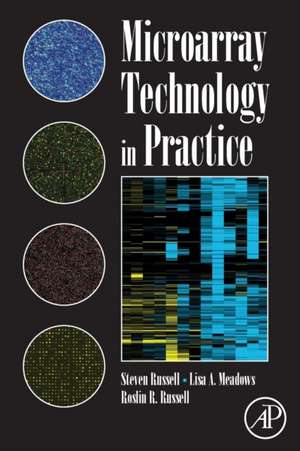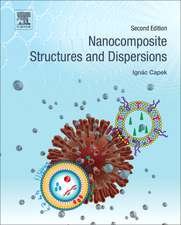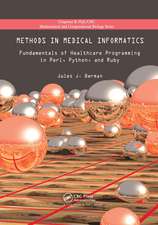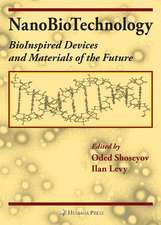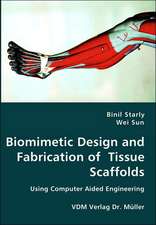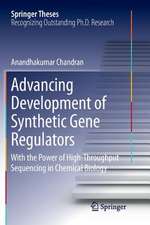Microarray Technology in Practice
Autor Steve Russell, Lisa A. Meadows, Roslin R. Russellen Limba Engleză Paperback – 17 noi 2008
- Cohesive overview of the technology and available platforms, followed by detailed discussion of experimental design and analysis of microarray experiments
- Up-to-date description of normalization methods and current methods for sample amplification and labeling
- Deep focus on oligonucleotide design, printing, labeling and hybridization, data acquisition, normalization, and meta-analysis
- Additional uses of microarray technology such as ChIP (chromatin immunoprecipitation) with hybridization to DNA arrays, microarray-based comparative genomic hybridization (CGH), and cell and tissue arrays
Preț: 281.98 lei
Preț vechi: 329.37 lei
-14% Nou
Puncte Express: 423
Preț estimativ în valută:
53.97€ • 58.65$ • 45.37£
53.97€ • 58.65$ • 45.37£
Carte tipărită la comandă
Livrare economică 14-28 aprilie
Preluare comenzi: 021 569.72.76
Specificații
ISBN-13: 9780123725165
ISBN-10: 012372516X
Pagini: 464
Dimensiuni: 152 x 229 x 25 mm
Greutate: 0.64 kg
Editura: ELSEVIER SCIENCE
ISBN-10: 012372516X
Pagini: 464
Dimensiuni: 152 x 229 x 25 mm
Greutate: 0.64 kg
Editura: ELSEVIER SCIENCE
Public țintă
Life science professionals and graduate studentsCuprins
Contents
1. What are microarrays?
A. The basics
2. Designing and producing a microarray
A. Platform options
B. Oligonucleotide design
C. Whole genome or boutique arrays
D. The problems of multiple testing
E. Array layout
F. Quality assessment
3. Sample collection and labelling
A. RNA extraction
B. Quality assessment
C. Direct labelling techniques
D. Indirect labelling techniques
E. End labelling techniques
F. Amplification techniques
G. Hybridization
4. Data acquisition
A. Scanners
B. Image acquisition
C. Multiple scans and data merging
D. Finding spots
E. Background measurement
G. Quality control basics
5. Experimental Design and Data Normalisation
A. Experimental design
B. Why normalize?
C. Unwanted signal variation
D. Common normalization approaches
E. Data transformation
F. Dealing with ‘S’-shaped trends
G. Replicates and spatial detrending
H. Normalization of single channel arrays
6. Meta analysis
A. Data filtering
B. Screening for differentially expressed genes
C. Hierarchical clustering
D. Other clustering techniques
E. Components analysis
F. Prediction tools
7. Data annotation, storage and submission
A. Functional data annotation
B. Microarray databases
C. Public repositories
8. Applications in health & disease
A. Malaria – parasite expression
B. Cancer classification
C. Diagnostic Arrays
9. It's not all gene expression
A. ChIP-array
B. CGH
C. Protein arrays
D. Cell arrays
1. What are microarrays?
A. The basics
2. Designing and producing a microarray
A. Platform options
B. Oligonucleotide design
C. Whole genome or boutique arrays
D. The problems of multiple testing
E. Array layout
F. Quality assessment
3. Sample collection and labelling
A. RNA extraction
B. Quality assessment
C. Direct labelling techniques
D. Indirect labelling techniques
E. End labelling techniques
F. Amplification techniques
G. Hybridization
4. Data acquisition
A. Scanners
B. Image acquisition
C. Multiple scans and data merging
D. Finding spots
E. Background measurement
G. Quality control basics
5. Experimental Design and Data Normalisation
A. Experimental design
B. Why normalize?
C. Unwanted signal variation
D. Common normalization approaches
E. Data transformation
F. Dealing with ‘S’-shaped trends
G. Replicates and spatial detrending
H. Normalization of single channel arrays
6. Meta analysis
A. Data filtering
B. Screening for differentially expressed genes
C. Hierarchical clustering
D. Other clustering techniques
E. Components analysis
F. Prediction tools
7. Data annotation, storage and submission
A. Functional data annotation
B. Microarray databases
C. Public repositories
8. Applications in health & disease
A. Malaria – parasite expression
B. Cancer classification
C. Diagnostic Arrays
9. It's not all gene expression
A. ChIP-array
B. CGH
C. Protein arrays
D. Cell arrays
